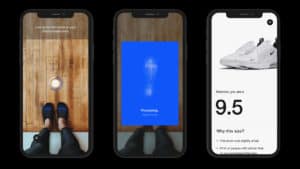Nike Inc.’s new Nike Fit app feature aims to help shoppers find shoes that fit and, in doing so, reduce the number of returns it has to process. The feature will launch in July.
Using the feature within the Nike app, a consumer can scan her foot using her smartphone camera. Nike Fit scans and collects 13 data points that map the consumer’s foot.

“We then translate those measurements into dimension data that we’re then able to compare to our full footwear assortment,” says Michael Martin, Nike’s vice president of digital products. “Based off of what we know about you, as well as our range of products, we’re then able to recommend your best fit for the particular Nike shoe you’re interested in.”
For example, after a consumer scans her foot, a Nike product detail page will only show the shopper her size, rather than a range of sizes. If a shopper goes to a different product page, Nike may show a different size, depending on the fit of the shoe because different shoes are made with different performance intentions. A running shoe, for instance, works best when it is snug while a sportwear shoe is designed to have more room for everyday wear.
In testing, the recommended size can range a size and half, Martin says.
Although most consumers have one foot that is slightly larger than the other, the difference is often a few millimeters and not enough to require a size increase, Martin says. Nike does not allow shoppers to purchase right and left shoes of different sizes, and its recommendation will be the best size for both feet, Martin says.
One of Nike’s goals of the feature is to reduce its return rate because it will likely give shoppers confidence that the shoes they buy will fit, Martin says.
“Nike Fit will significantly impact the existing customer behavior of buying several pairs online to try on at home and then shipping back the remainder,” he says.
About 500,000 consumers each year complain about purchasing the wrong shoe size, according to Nike’s U.S. customer service team without providing more details. Nike says the industry return rate for shoes is around 27%, although Martin declined to reveal Nike’s return rate.
Besides return rate, the fit feature will benefit Nike in several ways including incremental spend; sizing corrections; accurate foot data at scale; elevated in-store experience; demographic insights; manufacturing improvements; and enhanced consumer relationships, Martin says.
Nike has also trained its in-store associates to use this feature with shoppers in its retail locations.
Nike’s newly acquired computer vision firm Invertex Ltd. developed the Nike Fit features along with a Nike in-house cross-functional team of professionals in machine learning, user-experience design, bio mechanics, retail expertise and footwear design, Martin says.
This is not the first time a shoe retailer has developed a digital sizing tool: App-only Jenzy launched about a year ago with its focus on children’s shoes. Similar to Nike, shoppers take a photo of their child’s foot in the app, and the retailer will determine the child’s shoe size for each SKU, factoring in the type of shoe, material and lace type, as well as leaving room to grow.
Co-founder Carolyn Horner says Nike’s fit technology is good news as it validates their idea and normalizes the process of taking a picture of a foot to determine the size.
“[Nike has] set the pace for where the whole footwear market is going, and other shoe retailers will need to offer a similar service and experience to their customers to stay competitive,” Horner says.
Although a smaller retailer than Nike with only a few hundred product sales and only selling 22 brands, Jenzy is confident that its sizing tool is working. It has maintained a return rate of fewer than 5%, even when it has added brands to its platforms, Horner says.
“We have seen that with our early adopters; they come back to Jenzy season after season because we keep track of their child’s foot growth, recommend shoes based on previous items bought and send shoes that fit,” Horner says. “In fact, the metric we are most proud of is our repeat-customer rate.” Horner declined to reveal Jenzy’s repeat-purchase rate.
Jenzy recently completed a $1.25 million seed round.
Favorite